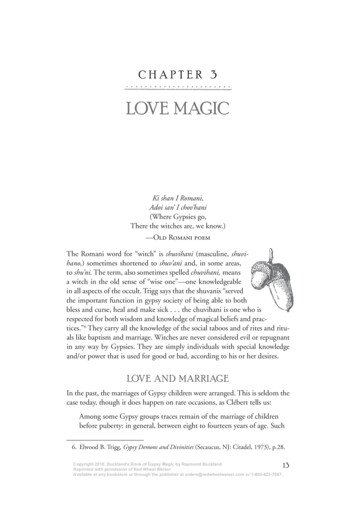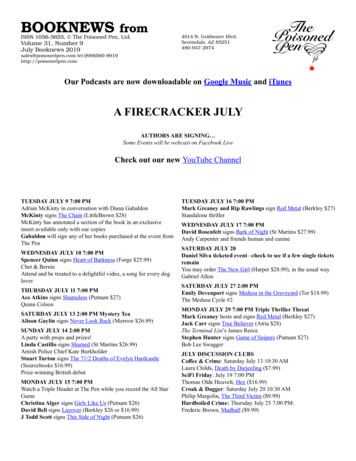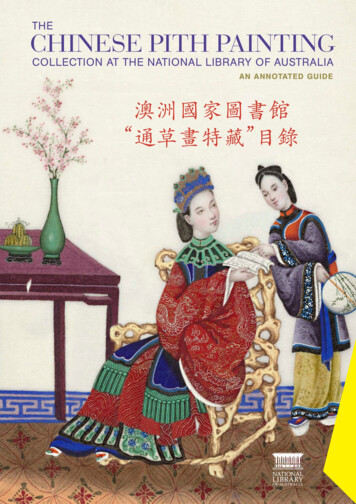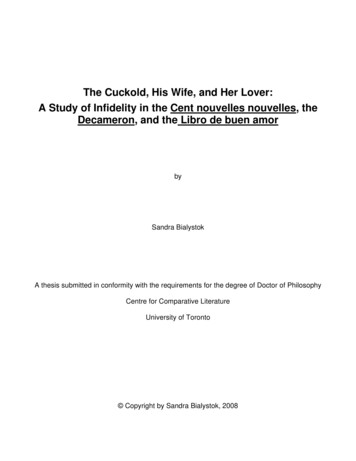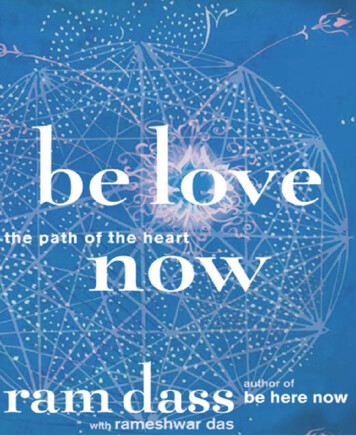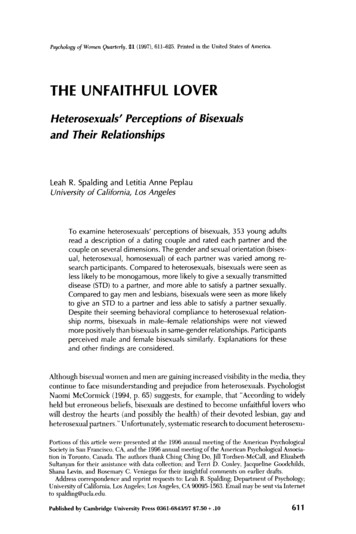
Transcription
Psychology of W a n Quorted!y, 21 (1997). 611-625. Printed in the United States of America.THE UNFAITHFUL LOVERHeterosexuals’ Perceptions of Bisexualsand Their RelationshipsLeah R. Spalding and Letitia Anne PeplauUniversity of California, Los AngelesTo examine heterosexuals’ perceptions of bisexuals, 353 young adultsread a description of a dating couple and rated each partner and thecouple on several dimensions. The gender and sexual orientation (bisexual, heterosexual, homosexual) of each partner was varied among research participants. Compared to heterosexuals, bisexuals were seen asless likely to be monogamous, more likely to give a sexually transmitteddisease (STD) to a partner, and more able to satisfy a partner sexually.Compared to gay men and lesbians, bisexuals were seen as more likelyto give an STD to a partner and less able to satisfy a partner sexually.Despite their seeming behavioral compliance to heterosexual relationship norms, bisexuals in male-female relationships were not viewedmore positively than bisexuals in same-gender relationships. Participantsperceived male and female bisexuals similarly. Explanations for theseand other findings are considered.Although bisexualwomen and men are gaining increased visibility in the media, theycontinue to face misunderstanding and prejudice from heterosexuals. PsychologistNaomi McCormick (1994, p. 65) suggests, for example, that “According to widelyheld but erroneous beliefs, bisexuals are destined to become unfaithful lovers whowill destroy the hearts (and possibly the health) o f their devoted lesbian, gay andheterosexualpartners.” Unfortunately, systematic researchto document heterosexuPortions of this article werc presented at the 1996 anriual meeting of the American PsychologicalSociety in San Francisco, CA, and the 1996 annual meeting of the American Psychological Association in Toronto, Canada. The authors thank Ching Ching Do, Jill Tordsen-McCall, and ElizabethSultanyan for their assistance with data collection; and Tern D. Conley, Jacqueline Goodchilds,Shana Levin, and Rosemary C. Veniegas for their insightful comments on earlier drafts.Address correspondence and reprint requests to: Leah R. Spalding; Department of Psychology;University of California, Los Angeles; Los Angeles, CA 90095-1563. Email may be sent via Internetto spalding@ucla.edu.Published by Cambridge University Press 0361-6843/97 7.50 .1061 1
612SPALDINC A N D PEPLAUals’ views about bisexuals is lacking. The best available information comes fromthe personal statements of bisexual men and women who have described theirexperiences in anthologies or to researchers (e.g., Hutchins & Kaahumanu, 1991;Weinberg, Wilhams, & Pryor, 1994). According to these personal accounts, heterosexuals’ perceptions of bisexuals incorporate five themes.MonogamyFirst, bisexuals are seen as rejecting sexual monogamy. Bisexuals are viewed aspromiscuous people who desire concurrent sexual relationships with both men andwomen and who pursue several sexual relationships at the same time (Hutchins &Kaahumanu, 1991; Shuster, 1987; Weinberg et al., 1994). For example, a bisexualman noted, “Some [heterosexual women] didn’t want to date me because theyfeared I would not be sexually faithful to them” (cited in Weinberg et al., 1994,p. 120). According to one bisexual woman, her partner worried that having “abisexual identity meant that I was declaring. . . my need to have my cake and eatit too. . . so the hardest part was convincing her. . . that I did not need a man anda woman in my life to be [bisexual]; that one person could fulfd me” (Anderson,1992, p. 171).Sexual RiskinessSecond, bisexuals are seen as particularly likely to contract sexually transmitteddiseases (STDs) through unsafe sexual practices and to spread these diseases totheir heterosexual partners (Shuster, 1991; Sumpter, 1991). McCormick (1994, p.65) suggested that “prejudiced heterosexuals falsely blame bisexuals for beingmembers of a promiscuous group that is responsible for spreading the AIDSepidemic and other sexually transmitted diseases to the heterosexual population.”As one bisexual man stated, “It’s awful. We are seen as camers of disease to theheterosexual community” (cited in Weinberg et al., 1994, p. 216).TrustThird, bisexuals are seen as romantically fickle, likely to deceive a partner abouttheir other romantic affairs, and unlikely to make a lasting commitment (George,1993; Hutchins & Kaahumanu, 1991). As one bisexual noted, “My ‘ex’ used to sayshe couldn’t trust me because I’m bi. . . . I would never leave someone for anyoneelse. I’m an extremely loyal and honest person, and it hurt not to have my girlfriendtrust me” (cited in Auk, 1994, p. 109).Sexual TalentFourth, bisexuals are seen as sexually talented lovers who enjoy an active sex lifeand who are highly knowledgeable and open-minded about sexuality (Hutchins &Kaahumanu, 1991). For example, some bisexuals report being perceived by hetero-
The Unfaithful Lover613sexuals as “chic, intriguing turn-ons” (Shuster, 1987, p. 66). Others may perceivebisexuals as having expert knowledge about sex or as using special sexual techniquesbecause of their experiences with both men and women.Relationship QualityBecause bisexuals are believed to reject the cultural ideal of monogamous andcommitted relationships,bisexuals’ romantic relationshipsmay be seen as generallypoor in quality-lower in love, satisfaction, and intimacy, and higher in conflictthan the relationships of heterosexuals.This would be parallel to research showingthat heterosexuals tend to perceive gay male and lesbian relationships as poorerin quality than heterosexual relationships (Testa, Kinder, & Ironson, 1987).In summary, bisexuals have often reported experiencing misunderstanding andnegative stereotypingfrom their partners and friends. To date, however, no researchhas systematically investigatedhow heterosexualsactually view bisexuals. The present study represents a first step toward understanding how heterosexuals perceivebisexual women and men. The five themes previously described suggest that beliefsabout bisexuals often center around their relationships-what they value ina relationship and how they treat their partners. Consequently, the strategy ofthis research was to ask heterosexuals to read a description of a person in a romantic relationship and then to evaluate that target person, his or her partner,and the couple. The gender and sexual orientation of the partners were variedsystematically so that some couples included a bisexual partner and others didnot. This study focused on comparisons among three types of couples, as will bedescribed.First, we compared participants’ perceptions of bisexuals versus heterosexualsin a mixed-gender (male-female) relationship. Is a bisexual woman dating a heterosexual man seen as similar to a heterosexual woman dating a heterosexual man?To the extent that heterosexuals use their own group as the implicit standard,stereotypes of bisexuals may be most apparent when compared to heterosexualtargets. For example, if bisexuals are seen as avoiding monogamous relationships,they may be viewed as more interested than heterosexuals in dating others outsidetheir current relationshipor as more likely to “cheat”on their partner. If bisexuals areperceived as risky sex partners, they may be seen as more likely than heterosexualstospread an STD to a partner. If bisexuals are seen as untrustworthy, they may beperceived as more likely than heterosexuals to become bored with their relationshipand to feel only weak commitment to their partner. If bisexuals are seen as sexualexperts, they may be judged as better able to satisfy a partner sexuallythan heterosexuals. Finally, if bisexuals are believed to have poorer relationships than heterosexuals, mixed-gender couples with one bisexual partner may be seen as less in loveand more conflicted than heterosexual couples.Second, we compared perceptions of bisexuals dating a same-gender versus another-gender partner on each of the five themes. For example, is a bisexual womandating a lesbian viewed as similar to a bisexual woman dating a heterosexual man?Or do the gender and sexual orientation of the bisexual’s partner alter perceptionsof the bisexual individual and of the relationship? Empirical research has not yet
614SPALDINC A N D P E P M Udetermined how perceptions of a bisexual person are influenced by hisher choiceof a romantic partner. Comparing perceptions of bisexuals with a same-genderhomosexual partner versus an other-gender heterosexual partner provides information about possible variations in the perceptions of bisexuals.Third, we compared perceptions of bisexuals versus homosexuals in a samegender relationship. For example, is a bisexual woman with a lesbian partner seenas similar to a lesbian with a lesbian partner? If heterosexuals simply have generalized beliefs about nonheterosexual individuals or about individuals in a same-genderrelationship, then descriptions of bisexuals, gay men, and lesbians might be similar.Heterosexual adults may have more differentiated perceptions, however. So, forinstance, they might view bisexuals as more promiscuous than homosexuals becausebisexuals can have partners of both sexes.In all of these comparisons, the possible impact of the gender of the bisexualperson was also analyzed. Do heterosexuals perceive bisexual men and womensimilarly or differently? No empirical research has addressed this question. Studiesof heterosexuals’perceptions of gay men and lesbians have found that gay men andlesbians are often seen as having the characteristics of opposite-gender heterosexuals(e.g., Laner ik Laner, 1979, 1980; Levitt & Klassen, 1974). For example, Kiteand Deaux ( 1987) asked heterosexuals to list characteristics of heterosexual andhomosexual men and women. Respondents characterized both heterosexual womenand gay men as “feminine,” and associated gay men with a “feminine walk andmannerisms,” “feminine clothing,” and a “high-pitched voice.” Heterosexual respondents also perceived both lesbians and heterosexual men as “masculine,”and associated lesbians with “masculine clothing,” “masculine appearance,” and being “athletic.” If heterosexuals see bisexuals as comparable to homosexuals, then they mayassume that bisexual men are similar to heterosexual women and bisexual womenare similar to heterosexual men. On the other hand, heterosexuals’lack of knowlegeabout bisexuality may lead them to form highly generalized impressions that minimize differences between male and female bisexuals.METHODParticipantsAn initial sample of 366 undergraduates enrolled in psychology courses participatedin this research as part of an in-class exercise. Because this study focused on theattitudes of heterosexuals, two self-reported gay male and lesbian students, sevenbisexual students, and four “unsure” students were excluded from analyses. Thefinal sample of 353 participants included more women (63.5%) than men (36.5%),with a similar gender ratio in each experimental condition. Participants were diversein their self-reported ethnic identity: 37% were identified as Asian Americans orPacific Islanders, 33% as European Americans, 17% as Latinos or Latinas, 5% asAfrican Americans, 5% reported other ethnic identities, and 3% did not reporttheir ethnic identity.
The Unfaithful Lover615DesignThe experiment used a between-subjects design with multiple independent variables. The first set of analyses compared perceptions of bisexuals to perceptionsof heterosexuals. Specifically, ratings of male and female bisexuals dating someoneof the other gender were compared to ratings of male and female heterosexualsdating someone of the other gender. These analyses involved only mixed-genderrelationships and used a 2 (bisexual or heterosexual target) x 2 (male or femaletarget) design. The second set of comparisons examined how evaluationsof bisexualsare affected by the gender of their partner. Specifically, ratings of male and femalebisexuals dating a gay man or lesbian, respectively, were compared to ratings ofmale and female bisexuals dating a female or male heterosexual, respectively. Theseanalyses involved only bisexual targets and used a 2 (male or female bisexualtarget) x 2 (same-gender or other-gender partner) design. The third set of analysescompared perceptions of bisexuals with a same-gender partner to perceptions ofgay men and lesbians with a same-gender partner. Consequently, these analysesinvolved only same-gender couples, and used a 2 (bisexual or homosexual target)x 2 (male or female target) design.For all analyses, the dependent variables were 23 ratings assessing characteristicsof each partner and the couple as a whole. These items evaluated monogamy,sexual riskiness, trustworthiness, sexual talent, and relationship quality.MaterialsOur approach in creating stimulus materials was similar to the approach used tostudy gender bias in performance evaluation. In this paradigm (e.g., Cash, Gillen, &Burns, 1977),participants evaluate male or female targets in a social context (e.g.,as “job applicants” for traditionally masculine, feminine, or gender-neutral jobs),and then rate the target’s qualifications to perform the job and likelihood of successin the job. Judgments about the target’s competence reflect both participants’stereotypes of men and women (the target group) and information about the specificcontext (e.g., the type of job). In the present study, participants read a descriptionof bisexual, homosexual, or heterosexual adults (the target groups) in the contextof a dating relationship (with brief information provided about the target person,the partner, and their relationship). Participants then rated the target person, thepartner, and the couple on a variety of relationship-related characteristics. Choosingthis approach had two benefits. First, the contextual information about the couplemade the task more comparable to perceptions of bisexuals that might actuallyoccur outside the laboratory. Second, the inclusion of contextual information madethe purposes of the study less obvious and may have reduced possible socialdesirability bias in evaluations.Couple DescriptionEach participant read one of eight couple descriptions. All descriptions were identical except for the gender and sexual orientation of the partners. (See the Appendixfor a sample couple description.) To create a description of a couple that was“goingsteady,”statements were adapted from the Relationship Events Scale (King &
616SPALDINC A N D PEPlAUChristensen, 1983), an instrument that describes relationship progress among datingcouples.All couples were presented as having dated for 6 months and as being currentlyinvolved in a romantic and sexual relationship that involved seeing each otherfrequently. A “quote” from the target described the relationship as “going great.”The partners were depicted as spending weekends together, often buying eachother small gifts, and arguing occasionally. The couple had talked about livingtogether, but decided to wait. Individual information was also given about thetarget and the partner. This included their ages (21 and 20 years old), majors inschool (Communication Studies and History), and hobbies (bicycling, photography,swimming,hiking, and listening to classical music). Majors and hobbies were chosento be gender neutral.The gender of the partners was varied by their name, either “Michael” or“Lisa” for the target and either “Jim” or ”Karen” for the partner. All four gendercombinations were included. The sexual orientation of the target and partner wasalso varied. Sexual orientation was operationalized by describing each partner aseither heterosexual, bisexual, gay male, or lesbian, with a corresponding sexualhistory. For example, the male bisexual target was described as follows: “Michaelis bisexual and has dated both men and women in the past.” Gay male, lesbian,and heterosexual targets and partners were included for comparison purposes, andwere described in a similar fashion. For example, the gay male target was describedas: “Michael is gay and has dated men in the past.” The female heterosexual targetwas described as: “Lisa is heterosexual and has dated men in the past.” Therefore,the eight couples used in this study were as follows, with the target listed firstand the partner listed second: bisexual womanheterosexual man, bisexual woman/lesbian, bisexual madheterosexual woman, bisexual madgay man, heterosexualwomanheterosexual man, heterosexual manheterosexual woman, lesbiadesbian,and gay madgay man.Ratings of Partnem and the RelationshipRespondents rated each partner and the relationship using items relevant to thefive themes of interest. All characteristics were measured using 9-point Likertscales (ranging from 1 not at all to 9 completely). Monogamy was assessed byfour items measuring the target’s “interest in dating other people,” how likely thetarget is to “cheat” on the partner, how worried the partner is that the target “willbe unfaithful,” and the likelihood that the partners “date other people.” These fouritems had an average item intercorrelation of .50, p .01. Sexual riskiness wasmeasured by a single item that addressed perceptions of how likely the target is“to give [the partner] an STD.” Trust was evaluated with three items measuringhow “concerned the partner is that the target “will leave the relationship,” how“worried the partner is about “trusting” the target, and the likelihood that thetarget “would become bored with the relationship.” These items had an averageitem intercorrelation of .43, p .01. Sexual talent was measured by ratings of thepartner’s “sexual attraction to” and “sexual satisfaction with”the target, and thequality of the couple’s sex life. These three items had an average intercorrelationof .61, p .01.Finally, relationship quality was assessed in three ways. Four items focused onthe target and assessed perceptions of the target’s feelings of “being in love with”
617The Unfaithful Loverthe partner, ‘‘emotionally close” to the partner, “satisfied in the relationship,” and“likely to make personal sacrifices for the relationship.”These items had an averageintercorrelation of .43, p .01. Four items assessed perceptions of the partner onthe same characteristics, and had an average item intercorrelation of 55,p .01.A third set of four items focused on the couple as a whole, and assessed perceptionsof how likely they were “to still be together in 1 year,” how “well adjusted theyseemed,how well they “got along with each other,” and how “good” their relationshipwas. These items had an average intercorrelation of .56, p .01.RESULTS AND DISCUSSIONIn general, participants rated the partners and their relationship favorably. Forexample, couples were seen as having a good relationship (M 7.18) and likely tostill be together in 1year (M 6.24).The target was typically seen as being in lovewith the partner (M 6.68) and not interested in dating others (M 2.65). Thispattern is not surprising as the couple description read by participants characterizedthe couple in positive terms. Nevertheless, there were important differences acrossconditions in how partners and couples were perceived, and these variations werethe focus of our analyses. Of central interest was whether heterosexualparticipantsevaluated bisexuals differently than people with other sexual orientations.Data analysis consisted of a series of multivariate analyses of variable (MANOVAs).A MANOVA is particularly useful for identifjmg patterns of significant differencesamong a cluster of correlated variables. Therefore, items were grouped by themeand analyzed using a series of MANOVAs. Because sexual riskiness was assessedby a single item, it was analyzed with analyses of variance (ANOVAs).Significant MANOVA results were further analyzed using a series of stepdownANOVAs (Stevens,1973).Stepdown ANOVAs identify significant differenceswithina group of correlated variables. Each stepdown ANOVA examines group differencesin a dependent measure while simultaneously controlling for the effects of thepreceding variables in the series. In this manner, stepdown ANOVAs are able touncover the variables “responsible”for the significant MANOVA result. Dependentvariables were entered into the stepdown ANOVAs in the order in which theywere listed in the Methods section.In all analyses, data were examined for gender of participant effects by includinga third factor, participant gender (male/female participant), to each MANOVA orANOVA. No significant interactions with the other independent variables werefound, and there were no main effects for participant gender on ratings of bisexualtargets. Therefore, data from male and female participants were combined for allanalyses reported below.Comparing Bisexuals and Heterosexuals inMale-Female RelationshipsOur first goal was to determine whether heterosexuals perceive bisexuals as similarto or different from heterosexuals.This comparison is important because heterosexual respondents may use heterosexuals as an implicit standard against which to
SPALDINC618ANDPEPLAUTable 1Comparing Ratings of Bisexuals and Heterosexuals in Mixed-Gender CouplesF valuesThemeMonogamy (4, 173)"Sexual riskiness (1, 177)Trust (3, 175)Sexual talent (3, 175)Relationship qualityTarget (4, 174)Partner (4, 173)Couple (4, 176)Main effect oftarget's gender1.635.12"0.631.980.892.94"0.46Main effect oftarget's sexual : All F values are based on multiple analyses of variance (MANOVAs), except for the F values forsexual riskiness, which are based on analyses of variance (ANOVAs). All gender x sexual orientationinteractions were nonsignificant.'Numhers in parenthesesare the degrees of freedom for the numerator (nnmberof items) and denominator (number of participants).* p .05, "*p ,001.judge individuals with other sexual orientations. A series of 2 (bisexual or heterosexual target) x 2 (male or female target) MANOVAs was performed for mixed-gendercouples on the four themes. In addition, a similar 2 x 2 ANOVA was performedon ratings of the single sexual-riskiness item. Results are presented in Table 1.Both the target's sexual orientation (bisexual or heterosexual) and gender affectedparticipants' evaluations. Contrary to expectation, however, ratings of trust wereunaffected by the target's gender or sexual orientation. The statistically significantfindings are detailed as follows.MonogamyAs expected, there was a significant main effect of sexual orientation on ratings ofmonogamy (see Table 1). Stepdown ANOVAs indicated that this main effect resulted from two variables. Specifically, bisexuals ( M 3 . 6 6 ) were seen as morelikely than heterosexuals (M 2.21) to be dating people other than their partner,F (1, 174) 19.54, p ,001. Bisexuals (M 3.84) were also seen as more likely tocheat on their partner than were heterosexuals ( M 2.92), F (1, 176) 10.29,p .01.Sexual RiskinessAs expected, bisexuals were associated with greater sexual riskiness than heterosexuals. An ANOVA indicated that bisexuals ( M 4.99) were seen as more likely togive an STD to their partner than were heterosexuals ( M 3.59),F (1,177) 21.58,p .001. The gender of the target also affected ratings. An ANOVA revealed thatmen ( M 4.55) were seen as more likely than women (M 3.82) to give an STDto their partner, F (1, 177) 5.12, p .05. There was no significant Sexual Orientation x Gender interaction, however, p .05.
The Unfaithful Lover619Sexual TalentThe MANOVA yielded a marginally significant main effect of sexual orientation,F (3, 175) 2.53, p ,059. Stepdown ANOVAs indicated that this main effect couldbe explained by ratings of sexual satisfaction. As expected, partners of bisexuals(M 6.95) were seen as more sexually satisfied than partners of heterosexuals( M 6.58), F (1,176) 5.78, p .05.Relationship QualityContrary to expectations, participants perceived the bisexual and heterosexualmixed-gender relationships as similar in quality (see Table 1).Bisexual and heterosexual targets were seen as equally close to their partner, in love, satisfied withthe relationship, and likely to make sacrifices for the sake of the relationship. Theonly significant difference concerned perceptions of the partner, who in this setof analyses was heterosexual. A significant main effect of gender on ratings of thepartner was further analyzed with stepdown ANOVAs. Heterosexual women ( M 6.64) were seen as more likely than heterosexual men ( M 5.89)to make sacrificesfor the sake of the relationship, F (1,173) 9.12, p .01.In summary, respondents perceived both commonalities and differences betweenheterosexuals and bisexuals in male-female relationships. Both were seen as equallytrustworthy and equally likely to have a satisfylng romantic relationship. Significantdifferences were found in the domain of sexuahty, however. Compared to heterosexuals, bisexuals were seen as less interested in dating one person exclusively, morelikely to cheat on a partner, and more likely to give an STD to a partner. Amarginally significant finding suggested that bisexuals were seen as better able tosatisfy their partners sexually.Comparing Bisexuals with Same-Gender vs.Other-Gender PartnersA second goal of this study was to determine if perceptions of bisexuals dependon whether they have a same-gender versus other-gender partner. For example,is a bisexual man seen differently if he is dating a heterosexual woman versus agay man? A series of 2 (male or female bisexual target) x 2 (same-gender or othergender partner) MANOVAs was performed. In addition, a similar 2 x 2 ANOVAwas performed on the single sexual-riskiness item. These results are presented inTable 2. Bisexual women and men were perceived similarly; no significant maineffects for gender were found. Bisexuals in mixed-gender and same-gender relationships were perceived to be similar in trustworthiness, STD risk, and general relationship quality. Significant lfferences were found in evaluations of monogamy andsexual talent, however. These differences are described in the next section.MonogamyThe MANOVA indicated a significant main effect of couple type on ratings ofmonogamy (see Table 2). Stepdown ANOVAs showed that this main effect wascaused by significant differences in ratings of the likelihood of cheating. Bisexualswere perceived as more likely to cheat on a heterosexual partner ( M 3.84) thanon a gay or lesbian partner ( M 2.86), F (1,161) 11.30, p .001.
SPALDINC620ANDPEPIAUTable 2Comparing Ratings of Bisexuals in Same-Gender vs. Mixed-Gender CouplesF valuesThemeMonogamy (4, 159)"Sexual riskiness (1, 163)Trust (3, 160)Sexual talent (3, 159)Relationship qualityTarget (4, 159)Partner (4, 158)Couple (4, 161)Main effect oftarget's genderMain effect ofcouple 1.590.371.19Note: AU F values are based on multiple analyses of variance (MANOVAs), except for the F values forsexual risldness, which are based on analyses ofvariance (ANOVAs).All gender x couple type interactionswere nonsignificant.'Numbers in parenthesesare the degrees of freedom for the numerator (numberof items) and denominator (number of participants), respectively.'I, .05.Sexual TalentThe MANOVA also yielded a significant main effect of couple type for sexual talent(see Table 2 ) . Stepdown ANOVAs indicated that this effect could be explained byratings of sexual satisfaction. Heterosexual partners (A4 6.95) were seen as moresatisfied with the bisexual's sexual skill than were homosexual partners ( M 6.41),F (1, 160) 8.94, p .01. This finding may indicate that respondents view heterosexuals as being more easily satisfied sexually than their gay or lesbian peers.Alternatively, bisexuals may be perceived as more skilled in satisfying other-genderrather than same-gender partners.Comparing Bisexuals and Homosexuals inSame-Gender RelationshipsA third goal of this research was to compare perceptions of bisexuals, lesbians, andgay men in a same-gender romantic relationship. For example, do heterosexualsperceive a bisexual woman with a lesbian partner as similar to a lesbian womanwith a lesbian partner, or are bisexuals seen as distinctive? A series of 2 (bisexualor homosexual target) x 2 (male or female target) MANOVAs was performed. Asimilar 2 x 2 ANOVA was performed on ratings of the single sexual-riskiness item.As shown in Table 3, participants perceived these groups as highly similar. Nosignificant main effects of target gender were found. Nor were there significantdifferences between bisexuals and homosexuals in perceived monogamy, trustworthiness, or relationship quality. Only two differences between bisexuals and homosexuals were found.
621The Unfaithful LoverTable 3Comparing Ratings of Bisexuals, Lesbians, and Gay Men in Same-Gender CouplesF valuesThemeMonogamy (4, 163)”Sexual riskiness (1, 166)Trust (3, 164)Sexual talent (3, 162)Relationship qualityTarget (4, 162)Partner (4, 162)Couple (4, 162)Main Effect ofTarget’s GenderMain Effect ofTarget’s Sexual 1.441.840.710.470.87Note: All F values are based on multiple analyses of variance (MANOVAs),except for the F values for sexualrisldness, which are based on analyses of variance (ANOVAs).All gender x sexual orientation interactions werenonsignificant.‘Numben in parentheses are the degrees of freedom for the numerator (number of items) and denominator(number of participant’s),respectively.‘ p -05.Sexual RiskinessA marginally significant effect of sexual orientation was found for sexual riskiness,F (1,166) 3.74, p ,055. Bisexuals ( M 4.51) were seen as more likely thangays or lesbians ( M 3.90) to give an STD to their same-gender partner. This isnoteworthy because it is consistent with the earlier finding showing that b
The Unfaithful Lover 61 3 sexuals as “chic, intriguing turn-ons” (Shuster, 1987, p.66). Others may perceive bisexuals as having expert knowledge about sex or as using special sexual techniques because of their experiences with both men and women. Relationship Quality Because bisexuals ar

